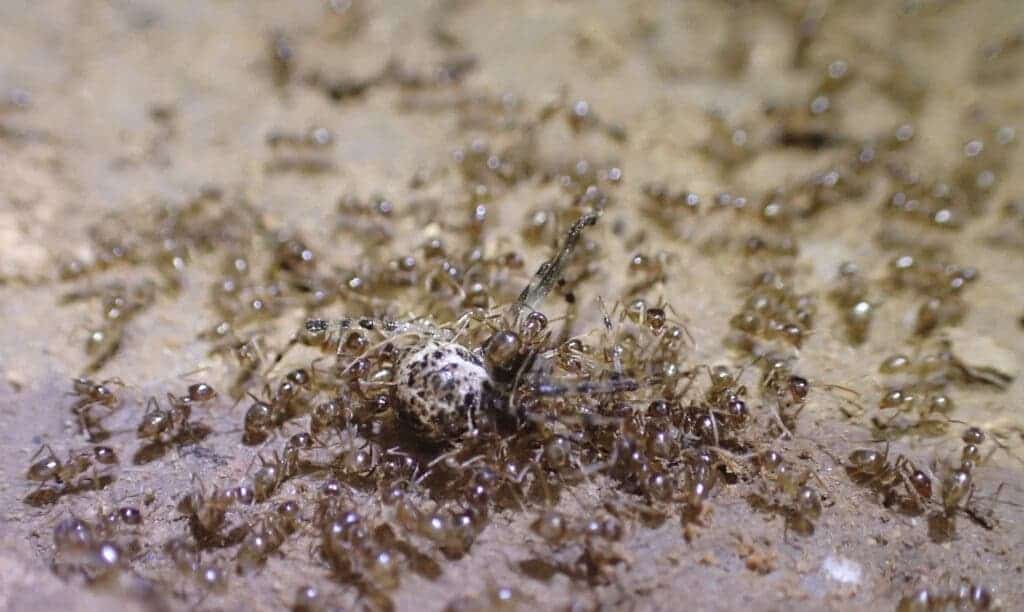When Rasberry crazy ants appear in North America, they wreak havoc. The species is native to South America, but has now invaded Texas and big parts of southeastern US, kicking out native insects and causing major headaches for homeowners. Even a NASA space center was invaded by these ants. But now, researchers report, they may have met their match in the most surprising of opponents: a fungus.

The ants are crazy
Rasberry ants may sound cute, but they’re not just called “rasberry ants” — they’re called “Rasberry crazy ants”, and there’s a reason for that. They originate from South America, and are common in Colombia, where many farmers know and fear them. Not only do these ants move in and displace native insect species (making them a very dangerous invasive species), but they can even threaten farm animals. Farmers have reported cases where chickens were asphyxiated by the ants, and even larger animals such as cattle are attacked around the eyes, nostrils, and hooves. Rasberry crazy ants can also destroy entire ecosystems by building their own farms. Essentially, the ants farm with plant-sucking insects (aphids) that they use for feeding, which can dry out large areas of grassland.
The ants are also very resilient: a 2014 study found that they are able to cover themselves with formic acid as an antidote against the venom of fire ants — the first known example of an insect being able to neutralize another insect’s venom. Colonies also have multiple queens, which enables them to survive if something happens to one of the queens.
All in all, rasberry crazy ants are excellent survivors, which is great for them, but bad for people whose houses they enter.
To make matters even worse, the species seems to be spreading throughout Texas and several parts of Mexico and the US. They often overrun houses, flooding the electrical system, AC, and any big enough holes they can find, causing shorts and a swarm of problems. Back in 2008, even NASA’s Johnson Space Center had an invasion which was handled by Tom Rasberry, the exterminator who first identified the ants in 2002 and lent them his name.
But researchers have found something that may defeat these super invasive ants.
Fungal kryptonite
Some 8 years ago, Rob Plowes and Lawrence Gilbert at Brackenridge Field Laboratory were studying rasberry crazy ants gathered from Florida, when they noticed something unusual: some of them had bloated abdomens filled with fat. When they looked closer, the researchers found spores from a microsporidian (a group of fungal pathogens); it was a species new to science. But the interesting things were just beginning.

Microsporidian pathogens often hijack the cells of insects and turn them into fat used to fuel spore factories. They’re so-called hyperparasites — parasites of parasites. It’s not clear where this particular microsporidian species came from, but it seems to do a great job at parasitising the ants. Researchers observed 15 ant populations for 8 years, noting that every population that had the pathogen declined — and most of them disappeared entirely. It was pretty surprising.
“You don’t expect a pathogen to lead to the extinction of a population,” LeBrun said. “An infected population normally goes through boom-and-bust cycles as the frequency of infection waxes and wanes.”
While it’s not clear exactly why this fungus hits these ants so hard, this gave researchers an idea: since other species don’t seem to be affected by it, what if the fungus was used as a way to control the ants?
They needed a test site to put their hypothesis to work — and the perfect site eventually came. At Estero Llano Grande State Park in Weslaco, Texas, in 2016, the rasberry crazy ants were causing mayhem. The park was losing its insects to the ants, and even snakes, lizards, and birds were severely affected. Rangers reported baby rabbits being blinded in their nests by swarms of ants. The situation was desperate.
“They had a crazy ant infestation, and it was apocalyptic, rivers of ants going up and down every tree,” LeBrun said. “I wasn’t really ready to start this as an experimental process, but it’s like, OK, let’s just give it a go.”
They gave it a go, and lo and behold — it worked. The team was sneaky about it: they placed hot dogs around the exit chambers to attract local ants. But they also put ants infected with the mushroom next to the hot dogs, to get the two groups to mingle. They did merge and within a year, the fungus brought devastation to the ant colonies. Within a year, virtually all colonies were infected. Within two years, their population started to plunge. Now, they’re virtually non-existent, and the native species are returning.
Researchers aren’t sure how long this will last, or if it’s permanent. But it seems to be a way to get rid of these ants and all the harm they bring, and given how problematic the species are and how much they’re spreading, it’s worth the shot.
“This doesn’t mean crazy ants will disappear,” LeBrun said. “It’s impossible to predict how long it will take for the lightning bolt to strike and the pathogen to infect any one crazy ant population. But it’s a big relief because it means these populations appear to have a lifespan,” said LeBrun
“I think it has a lot of potential for the protection of sensitive habitats with endangered species or areas of high conservation value,” the researcher concludes.
The study was published in PNAS.






